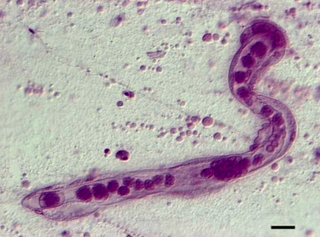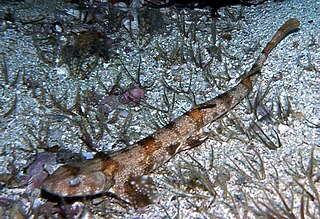
An octopus is a soft-bodied, eight-limbed mollusc of the order Octopoda. The order consists of some 300 species and is grouped within the class Cephalopoda with squids, cuttlefish, and nautiloids. Like other cephalopods, an octopus is bilaterally symmetric with two eyes and a beaked mouth at the center point of the eight limbs. The soft body can radically alter its shape, enabling octopuses to squeeze through small gaps. They trail their eight appendages behind them as they swim. The siphon is used both for respiration and for locomotion, by expelling a jet of water. Octopuses have a complex nervous system and excellent sight, and are among the most intelligent and behaviourally diverse of all invertebrates.

A cephalopod is any member of the molluscan class Cephalopoda such as a squid, octopus, cuttlefish, or nautilus. These exclusively marine animals are characterized by bilateral body symmetry, a prominent head, and a set of arms or tentacles modified from the primitive molluscan foot. Fishers sometimes call cephalopods "inkfish", referring to their common ability to squirt ink. The study of cephalopods is a branch of malacology known as teuthology.

The Mesozoa are minuscule, worm-like parasites of marine invertebrates. Generally, these tiny, elusive creatures consist of a somatoderm of ciliated cells surrounding one or more reproductive cells.

Looney Tunes is an American animated comedy short film series created by Leon Schlesinger, Hugh Harman and Rudolf Ising and distributed by Warner Bros. The series originally ran from April 19, 1930, to July 26, 1969, concurrently with its partner series Merrie Melodies, during the golden age of American animation. There are shorts that had been produced after the golden age, with the latest theatrical short under the Looney Tunes banner released on June 10, 2014. The two series introduced a large cast of characters, including Bugs Bunny, Daffy Duck, and Porky Pig. The term Looney Tunes has since been expanded to also refer to the characters themselves.

The common starling, also known as the European starling in North America and simply as the starling in Great Britain and Ireland, is a medium-sized passerine bird in the starling family, Sturnidae. It is about 20 cm (8 in) long and has glossy black plumage with a metallic sheen, which is speckled with white at some times of year. The legs are pink and the bill is black in winter and yellow in summer; young birds have browner plumage than the adults. It is a noisy bird, especially in communal roosts and other gregarious situations, with an unmusical but varied song. Its gift for mimicry has been noted in literature including the Mabinogion and the works of Pliny the Elder and William Shakespeare.

Charles Adams Claverie, known by stage names Charlie Hamburger, Charlie Kennedy and Charles Rocket, was an American actor, comedian, musician, and television news reporter. He was a cast member on Saturday Night Live, played the villain Nicholas Andre in the film Dumb and Dumber, and played Dave Dennison in Disney's Hocus Pocus.

Dicyemida, also known as Rhombozoa, is a phylum of tiny parasites that live in the renal appendages of cephalopods.

Octopus is the largest genus of octopuses, comprising more than 100 species. These species are widespread throughout the world's oceans. Many species formerly placed in the genus Octopus are now assigned to other genera within the family. The octopus has 8 arms, averaging 20 cm long for an adult.

The giant Pacific octopus, also known as the North Pacific giant octopus, is a large marine cephalopod belonging to the genus Enteroctopus. Its spatial distribution includes the coastal North Pacific, along Mexico, The United States, Canada, Russia, Eastern China, Japan, and the Korean Peninsula. It can be found from the intertidal zone down to 2,000 m (6,600 ft), and is best adapted to cold, oxygen-rich water. It is arguably the largest octopus species.

The sharptooth houndshark, or spotted gully shark is a species of houndshark in the family Triakidae found in shallow inshore waters from southern Angola to South Africa. Favoring sandy areas near rocky reefs and gullies, it is an active-swimming species that usually stays close to the bottom. This robust shark reaches 1.7 m (5.6 ft) in length and has characteristically large, rounded fins; the pectoral fins in particular are broad and sickle-shaped in adults. It also has a short, blunt snout and long furrows around its mouth. This species is gray or bronze in color above, with variable amounts of black spotting.

The puffadder shyshark, also known as the Happy Eddie, is a species of catshark, belonging to the family Scyliorhinidae, endemic to the temperate waters off the coast of South Africa. This common shark is found on or near the bottom in sandy or rocky habitats, from the intertidal zone to a depth of 130 m (430 ft). Typically reaching 60 cm (24 in) in length, the puffadder shyshark has a slender, flattened body and head. It is strikingly patterned with a series of dark-edged, bright orange "saddles" and numerous small white spots over its back. The Natal shyshark, formally described in 2006, was once considered to be an alternate form of the puffadder shyshark.

Neoechinorhynchidae is a family of parasitic worms from the order Neoechinorhynchida.
Dicyema shimantoense is a parasitic worm of the phylum Dicyemida. It is a vermiform mesozoan parasite that infects the renal appendages of the cephalopod Octopus sasakii. The name is derived from the Shimanto River, which is the longest river in Shikoku, and flows into Tosa Bay. A study from 2000-06 used 59 specimens obtained from fishermen at Tosa Bay and Kii Strait Japan. O. sasakii is a cephalopod found mainly in the shallow-water of Southern Japan. Research found that only those of certain sizes and geographical locations can be infected by D.shimantoense.

Sepioteuthis lessoniana, commonly known as the bigfin reef squid, glitter squid or oval squid, is a species of loliginid squid. It is one of the three currently recognized species belonging to the genus Sepioteuthis. Studies in 1993, however, have indicated that bigfin reef squids may comprise a cryptic species complex. The species is likely to include several very similar and closely related species.

The Dicyemidae is a family of tiny parasites that live in the renal appendages of cephalopods. It contains the following genera and species:
Octopus sasakii is a species of octopus found only in salt water. This species is a taxon inquirendum.

Sepia elegans, the elegant cuttlefish, is a species of cuttlefish in the family Sepiidae from the eastern Atlantic Ocean and the Mediterranean Sea. It is an important species for fisheries in some parts of the Mediterranean where its population may have suffered from overfishing.

Sepioloidea lineolata or more commonly known as the striped pyjama squid or the striped dumpling squid is a type of bottletail squid, that inhabits the Indo-Pacific Oceans of Australia. Although it is almost a cuttlefish, it does not have a cuttlebone; it is otherwise exactly the same as cuttlefish. Therefore it is a sepioid, not a real cuttlefish. However, it is usually referred to as a cuttlefish for public simplification. It is not a squid either. The striped pyjama squid lives on the seafloor and is both venomous and poisonous. When fully mature, a striped pyjama squid will only be about 7 to 8 centimetres in length. Baby striped pyjama squids can be smaller than 10 millimetres (0.39 in).

Dicyemennea is a genus of worms belonging to the family Dicyemidae.
















